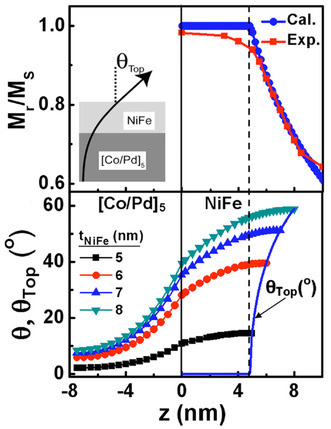Tilted Anisotropy

The use of a spin polarizing layer with a tilted magnetization [1-3] for use in spin torque oscillators has been recently proposed. Here, the fixed layer magnetization is tilted out of the film plane in order to simultaneously achieve zero-field operation without the need for additional read out layers and high output power [4]. Varying the tilt angle introduces an additional degree of freedom and leads to a rich phase diagram of spin transfer torque switching and precession [5]. Our approach relies on taking advantage of the competition between materials with distinct anisotropy directions. For example, by exchange coupling a NiFe layer with dominant in-plane shape anisotropy with a [Co/Pd] multilayer with perpendicular anisotropy a highly tunable range of tilt angles can be achieved.
[1] T. N. Anh Nguyen, et al., Appl. Phys. Lett. 98, 172502 (2011).
[2] T. N. Anh Nguyen, et al., J. Magn. Magn. Mat. 324, 3929 (2012).
[3] S. Chung, et al., J. Phys. D: Appl. Phys. 46, 125004 (2013).
[4] Y. Zhou, et al., Appl. Phys. Lett. 92, 262508 (2008).
[5] Y. Zhou, et al., New J. Phys. 11, 103028 (2009).
[1] T. N. Anh Nguyen, et al., Appl. Phys. Lett. 98, 172502 (2011).
[2] T. N. Anh Nguyen, et al., J. Magn. Magn. Mat. 324, 3929 (2012).
[3] S. Chung, et al., J. Phys. D: Appl. Phys. 46, 125004 (2013).
[4] Y. Zhou, et al., Appl. Phys. Lett. 92, 262508 (2008).
[5] Y. Zhou, et al., New J. Phys. 11, 103028 (2009).